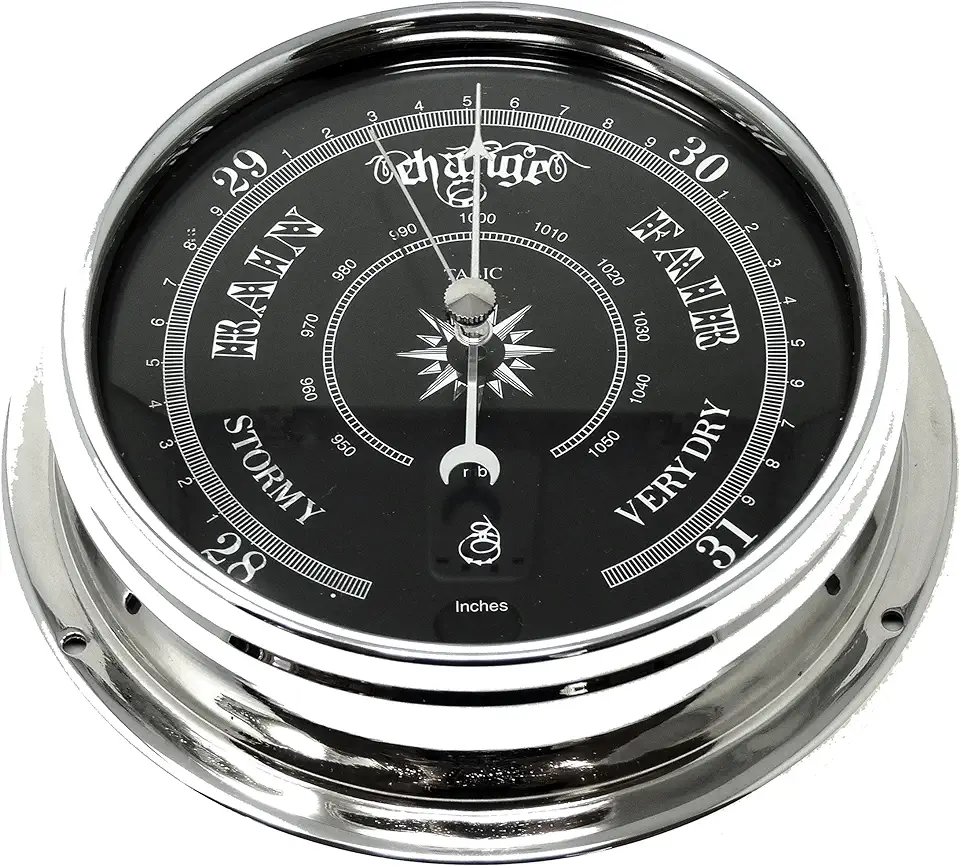Discover the benefits of sweatbands for your fitness routine. Enhance your performance and stay comfortable with these stylish and functional accessories.


Welcome to our comprehensive guide on aneroid barometers. In this article, we will explore what an aneroid barometer is, how it works, its history, and its various applications. Whether you are a weather enthusiast, a collector, or simply curious about it, this guide will provide you with all the information you need to know.
An aneroid barometer is a device used to measure atmospheric pressure. It consists of a sealed metal chamber, known as an aneroid cell, which expands or contracts in response to changes in air pressure. This expansion and contraction are then translated into a mechanical movement, which can be read on a dial or displayed digitally.
An aneroid barometer works on the principle of a flexible metal chamber. The aneroid cell is typically made of a thin metal, such as beryllium copper or phosphor bronze, which is highly sensitive to changes in pressure. When the atmospheric pressure increases, the metal chamber contracts, and when the pressure decreases, it expands.
The aneroid cell is connected to a system of levers and gears, which amplify the small movements of the chamber. This mechanical movement is then displayed on a dial or converted into a digital reading. The dial usually has markings for both inches of mercury (inHg) and millibars (mb), which are the two most common units of pressure measurement.
The invention of the aneroid barometer is credited to Lucien Vidi, a French engineer, who patented the design in 1844. However, the concept of using a flexible metal chamber to measure pressure dates back to the 17th century.
Before the invention of the aneroid barometer, the most common type of barometer was the mercury barometer, which used a column of mercury to measure pressure. While mercury barometers were accurate, they were bulky, fragile, and required regular maintenance.
The invention of the it revolutionized pressure measurement. Aneroid barometers were smaller, more portable, and less prone to damage. They quickly gained popularity and became the preferred choice for many meteorologists, sailors, and outdoor enthusiasts.
Aneroid barometers have a wide range of applications, both in professional settings and for personal use. Here are some of the most common applications:
One of the primary uses of aneroid barometers is in weather forecasting. Changes in atmospheric pressure can indicate approaching weather systems, such as storms or high-pressure systems. By monitoring the pressure trends, meteorologists can make predictions about the weather conditions.
Aneroid barometers can also be used to measure altitude. As you ascend or descend in elevation, the atmospheric pressure changes. By comparing the pressure readings at different elevations, you can determine your approximate altitude.
Aneroid barometers are essential instruments in aviation. They are used in altimeters, which provide pilots with accurate altitude readings. Altitude is crucial for navigation, especially during takeoff, landing, and when flying at different flight levels.

Mariners rely on aneroid barometers to monitor changes in atmospheric pressure, which can indicate approaching storms or changes in weather conditions. This information is crucial for safe navigation and avoiding hazardous weather conditions at sea.
Many people also use it for personal use and collecting. Aneroid barometers can be beautiful and intricate pieces of craftsmanship, often housed in decorative cases. They can be displayed as decorative items or used to monitor changes in atmospheric pressure for personal interest.
If you are considering purchasing it, there are a few factors to consider:
Accuracy is an essential factor to consider when choosing an aneroid barometer. Look for a barometer that has been calibrated and tested for accuracy. Some barometers may also have adjustment screws or knobs to fine-tune the readings.
Aneroid barometers come in a variety of designs and styles. Consider the aesthetics and choose a barometer that matches your personal taste and the decor of your home or office.
Some aneroid barometers may have additional features, such as a built-in thermometer or hygrometer (humidity measurement). Consider whether these additional features are important to you and if they align with your needs.
Price is another factor to consider when choosing it. Set a budget and look for options within your price range. Remember to balance price with quality and features.
To ensure accurate readings and longevity, it is essential to properly maintain your aneroid barometer. Here are some maintenance tips:
Calibrate your aneroid barometer regularly to ensure accurate readings. This can be done using a known reference barometer or by comparing the readings with a reliable weather station.
Avoid exposing your aneroid barometer to extreme temperatures, as this can affect its accuracy and performance. Keep it away from direct sunlight, heaters, or air conditioning vents.
Regularly clean and dust your aneroid barometer to keep it in good condition. Use a soft, lint-free cloth to wipe the surface and remove any dust or dirt.
Handle your aneroid barometer with care to avoid damage. Avoid dropping it or subjecting it to sudden impacts. If you need to transport it, use a padded case or wrap it in a soft cloth for protection.

There are several different types of aneroid barometers, each with its own unique features and design. Here are some of the most common types:
Desktop barometers are designed to be placed on a desk or tabletop. They are typically larger in size and have a stand or base for stability. Desktop barometers often have a classic design and are popular among collectors.
Wall barometers are designed to be mounted on a wall. They are usually smaller in size and have a hinged or removable front cover. Wall barometers are commonly found in homes and offices, and they can add a touch of elegance to any room.
Marine barometers are specifically designed for use at sea. They are built to withstand the harsh conditions of the marine environment, including exposure to saltwater and extreme weather. Marine barometers are often housed in a sturdy and waterproof case.
Compensated barometers are designed to compensate for changes in temperature and altitude. They have additional mechanisms or features that allow for more accurate readings, even in varying conditions. Compensated barometers are commonly used in aviation and mountaineering.
Antique barometers are barometers that were made in the past and are considered collectibles. They often have intricate designs, ornate cases, and historical value. Antique barometers can be a great addition to any collection or a unique piece of decor.
Reading an aneroid barometer is relatively straightforward. Here are the steps to follow:
Take a moment to familiarize yourself with the dial of the barometer. Look for the markings indicating inches of mercury (inHg) and millibars (mb). The dial may also have additional markings for different weather conditions.
Observe the position of the needle on the dial. The needle indicates the current atmospheric pressure. It may point to a specific number or fall within a range of numbers.
Interpret the reading based on the numbers and markings on the dial. For example, if the needle is pointing to a higher number, it indicates high pressure, which is often associated with clear and sunny weather. If the needle is pointing to a lower number, it indicates low pressure, which is often associated with cloudy or stormy weather.
Keep an eye on the pressure trends by regularly checking the barometer. Note whether the needle is rising, falling, or staying steady. This can provide valuable information about changing weather patterns.
Here are some tips to help you make the most of your aneroid barometer:
Choose a location for your barometer where it can accurately measure the atmospheric pressure. Avoid placing it near sources of heat or cold, such as radiators or windows, as this can affect the readings.
Ensure that the barometer is level to obtain accurate readings. Use a spirit level or a built-in level (if available) to check the horizontal position of the barometer.

Calibrate your barometer regularly to maintain accuracy. This can be done by comparing the readings with a known reference barometer or a reliable weather station. Adjust the barometer if necessary using any adjustment screws or knobs provided.
Monitor the readings on your barometer and observe any patterns in relation to the weather conditions. Over time, you may start to notice correlations between pressure changes and specific weather patterns in your area.
Consider keeping a record of the barometer readings along with the corresponding weather conditions. This can help you establish patterns and make more accurate weather predictions in the future.
Aneroid barometers can be highly accurate if they are properly calibrated and maintained. However, it is important to note that no barometer is 100% accurate, as atmospheric pressure can vary due to local conditions and other factors.
Yes, aneroid barometers are commonly used for weather forecasting. Changes in atmospheric pressure can indicate approaching weather systems, and by monitoring the pressure trends, meteorologists can make predictions about the weather conditions.
It is recommended to calibrate an aneroid barometer at least once a year to ensure accurate readings. However, if you notice any significant discrepancies or if the barometer has been subjected to extreme conditions, it may be necessary to calibrate it more frequently.
In some cases, aneroid barometers can be repaired if they stop working. However, the extent of the repair will depend on the specific issue and the availability of replacement parts. It is best to consult a professional or the manufacturer for repairs.
Aneroid barometers can be used at high-altitude locations, but it is important to consider the effects of altitude on pressure readings. As you ascend to higher altitudes, the atmospheric pressure decreases, which can affect the accuracy of the barometer. Some barometers may have adjustable settings to compensate for altitude changes.

Aneroid barometers are versatile instruments that have been used for centuries to measure atmospheric pressure. They find applications in weather forecasting, aviation, marine navigation, and personal use. When choosing an aneroid barometer, consider factors such as accuracy, design, features, and price. Proper maintenance, including regular calibration and careful handling, is essential to ensure accurate readings and prolong the lifespan of your barometer. Whether you are a weather enthusiast, a collector, or simply appreciate the beauty of barometers, aneroid barometers are fascinating devices worth exploring.
An aneroid barometer is a versatile and useful instrument for measuring atmospheric pressure. Whether you use it for weather forecasting, altitude measurement, or simply as a decorative item, it can provide valuable information and add a touch of elegance to any space. By understanding how to read and use an aneroid barometer correctly, you can make the most of its features and enhance your weather monitoring experience.
In conclusion, aneroid barometers are versatile instruments used to measure atmospheric pressure. They have a long history and find applications in weather forecasting, aviation, marine navigation, and personal use. When choosing this, consider factors such as accuracy, design, features, and price. Proper maintenance is essential to ensure accurate readings and prolong the lifespan of your barometer. Whether you are a weather enthusiast or simply appreciate the beauty of barometers, these are fascinating devices worth exploring.